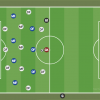I write to you regarding an alternative proposal for the changes to the Formula One technical regulations for 2017 and beyond.
I have been employed as an engineer within various F1 teams for ten seasons now, so am aware of the political manoeuvring that can be involved in the process of changing regulations; I do not expect anything to come of my writing but hope that it may raise a few questions or result in some lateral thinking in the minds of those who are deciding the future technical direction of the sport, for the good of the sport.
Instantaneous power of a Formula One car's internal combustion engine is currently limited by the installation of a mandatory, homologated FIA fuel flow sensor; a value for maximum allowed fuel flow is set, dependant upon engine speed, and if a car breaches this limit it may be disqualified.
What stops us applying a similar principle to another key area of car performance - aerodynamics?
All of the cars are already fitted with strain gauge load cells in their push or pull rod suspension members, from which teams can infer vertical loads at the four tyre contact patches. A car's static weight in the garage can be calculated from the sum of the loads in all four push or pull rods. A car's downforce when out on circuit can be calculated from any increase in this sum.
If we simply replace the current load cells with mandatory, homologated FIA ones, the total vertical load on each car can be monitored by the governing body throughout a race in the same way that they currently monitor fuel flow. If the technical regulations state that this may not have increased (within a practicable tolerance) at any time during a race from a value recorded as the car enters parc ferme at the end of that race, plus the 100kg maximum allowable fuel weight, then it is possible to prevent cars from generating aerodynamic downforce, without the need for any of the current, complicated and very restrictive bodywork rules. Note that the FIA would not need to know the absolute vertical loads at the contact patches, just any percentage increases in the sum of the load cell readings from the value recorded at the end of each race. This allows for a common load cell to be used on various cars with differing suspension geometries.
Throughout the course of a race, the weight of a car will reduce as its fuel is burnt. This opens up the possibility of a car having small amounts of aerodynamic downforce being added incrementally during each pitstop by adjustment of aerodynamic devices and without the total vertical load on the car breaching the allowable limit. In order to prevent this, a simple rule could be added to the regulations preventing teams from making any such adjustments during the course of a race.
Certain circuits or corners with dramatic elevation changes (Eau Rouge at Spa being the classic example) will result in the total vertical load on a car increasing, regardless of it generating aerodynamic downforce or not. There are various ways to accommodate this. One option would be for the data channel recording the vertical load having a filter applied such that it ignores momentary spikes. An alternative would be to allow the load limit to be breached within a particular demarcated section of a circuit.
The generation of aerodynamic downforce being effectively eliminated opens up a raft of implications for the fundamental design of the cars, their public perception and how they would race against each other:
• Cars will be able to follow each other more closely throughout a lap without suffering a loss of performance through reduced aerodynamic downforce. This will significantly aid close racing and overtaking.
• Braking distances will increase, again aiding overtaking.
• Cornering speeds will be reduced, although the specification of different tyre compounds and sizes could at least partially offset this if required.
• End-of-straight top speeds will increase, although an increase in tyres sizes could again be used to reduce them slightly again.
• The current, restrictive aerodynamic regulations, where the layout of a car's bodywork and aerodynamic devices is defined by a plethora of dimensioned boxes within which bodywork is or is not allowed, could in many cases be completely removed from the rulebook. Within existing safety constraints, we could once again have cars which look different from one another.
• Teams can maintain their aerodynamic design departments, but their work will only be used to produce a stable platform for the driver, to increase straight line speeds and to reduce fuel consumption through the reduction of aerodynamic drag. This draws the aerodynamic development direction more in line with that of the current hybrid powertrains by being more road-relevant and focusing on overall vehicle efficiency.
• Cars will be lighter, as the peak loads put into the main structure and suspension will be lower. This will also benefit overall vehicle efficiency.
• Suspension systems will potentially be simplified and reduced in cost as many of the complicated systems currently used to control the aerodynamic platforms of the cars under varying loads will become redundant.
I hope that you find this proposal of interest and that it may play at least a small part in the future of the sport of Formula One being a healthy one full of exciting cars and close racing.
Yours faithfully,
Christopher Kerr















